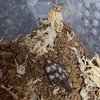grommthemans
Arachnopeon
- Joined
- Feb 21, 2020
- Messages
- 4
I caught this girl running around my house a few months back and decided to keep her but now that she's on her second batch of babies I figure its time to pinpoint her exact species so I can look into taking better care of her and her offspring. I figure she's a bark scorpion of some kind and she's obviously from central Florida.





